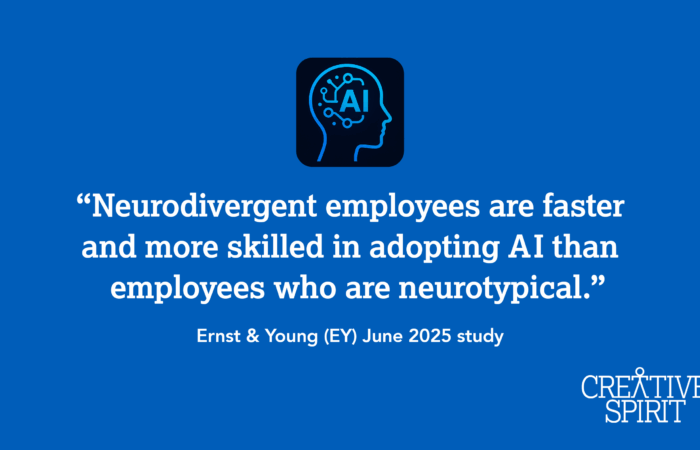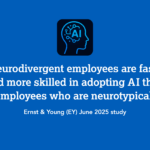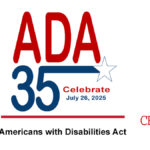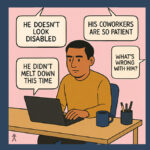By Menachem Rephun, Communications Manager, Creative Spirit
From the passage of the Americans with Disabilities Act (ADA) in 1990, to major improvements in physical and digital accessibility, to increased awareness and appreciation of neurodiversity, society has made significant progress in advancing disability rights and neurodiverse inclusion over the past few decades. Sadly, unconscious bias, lack of reasonable accommodations, and uncertainty about whether or not to disclose are still obstacles routinely faced by many neurodivergent professionals. That’s where Employee Resource Groups (ERGs) come in. These voluntary, employee-led groups, based around a shared interest or identity, can be a game-changer for neurodiverse inclusion in the workplace. Through ERGs, employees who are neurodivergent can build a sense of community and belonging that boosts confidence, advocacy, and morale. That creates a ripple effect, enhancing the entire company with fresh approaches and ideas as neurodivergent employees are given a platform and are empowered to deliver their best work. “ERGs do more than just share stories,” Sarah Harnett, Senior Director at Greenhouse Software, writes. “They’re powerful educational tools. Through workshops, seminars, and training sessions, ERGs help demystify neurodiversity, highlighting both the unique strengths and challenges faced by neurodivergent individuals.” As Harnett points out, CIPD’s “Neuroinclusion at Work” report found that only 30% of employers have conducted neurodiversity awareness training for all staff in the past 2 years (as of her writing in 2024). On the other hand, 90% of Fortune 500 companies have ERGs, according to a 2017 report from Forbes. In a recent episode of the podcast AskNeurowork, Kate Hardiman, founder and CEO of Unified360, echoed Harnett’s sentiment, describing neurodiverse ERGs as “more than just a support group. [They’re] a way to nurture change and create a workplace where everyone feels valued and included.”
With 53% of Gen Z now identifying as neurodivergent, and 19% of Americans identifying as neurodivergent overall (according to a 2024 YouGov poll), there is even more of an incentive for companies to establish ERGs that can maximize neurodiverse talent. According to TextHelp.com, a report from the Society for Human Resource Management (SHRM) found that 90% of companies examined said that ERGs helped make new employees more comfortable during the onboarding process. The report also found that 70% of companies relied on ERGs to build a workforce that reflects the demographics of their customer base. Employers who have helped set up neurodiverse ERGs have also commented on the positive results and benefits they’ve seen. One of those business leaders is Pierre Escaich, Neurodiversity Talent Program Director for the video game studio Ubisoft. “Very quickly we establish[ed] a private forum for our members,” Escaich said in a webinar for Uptimize. “And quite spontaneously we created a peer support community…now we have an online platform, we [have a] peer support group for ADHD, autism, gifted…and soon dyslexia. Many people are saying that the existence of the group is bringing them hope, meaning, and purpose, because they find there an opportunity to share [that] they are really concerned at work, without fear of being judged.” That accepting, non-judgmental atmosphere is one that all companies should strive for, and neurodiverse ERGs can make it happen.
So You Want to Build a Neurodiverse ERG
Neurodiverse ERGs are vital not just for inclusion, but for advocacy. Through ERGs, neurodivergent employees have an outlet for sharing their concerns and needs. With that in mind, the next question is obvious: how do you actually create an ERG? In an article for In the Know, Sandeep Bains, a neurodiversity advocate and leadership consultant, outlines a step-by-step guide for employees on how to set up and maintain a neurodiverse ERG. The preliminary step, Baines writes, is knowing whether enough people are on board. Through surveys and focus groups, employees can gauge the level of support and potential membership base for the ERG. If the interest and enthusiasm are there, the next step is securing leadership buy-in. This might seem more intimidating, but as Bains points out, leaders can be persuaded with data on the positive impact of ERGs on employee well-being, innovation, and talent recruitment. An ERG’s success depends on employers appreciating the substantial amount that neurodivergent employees have to offer in both skills and talent, recognizing neurodiversity as a competitive advantage that benefits not only neurodivergent professionals but the company as a whole.
After gauging interest and securing leadership support, the third step of the ERG creation process involves clearly defining the ERG’s mission statement and setting up goals that align with that mission. Baines emphasizes that these goals should be specific, measurable, achievable, relevant, and time-bound (SMART). Some examples include mentorship programs for employees who are neurodivergent, internal workshops that can help raise awareness about neurodiversity, and working with HR to improve recruitment practices for hiring employees who are neurodivergent.
We’re Putting Together a Team
Congrats! You’ve achieved leadership buy-in, established your neurodiverse ERG, and clearly defined its mission and goals. Now comes the fun part: recruiting and assembling a team, more specifically, a leadership team that reflects your company’s diverse neurodivergent community. One challenge with this step of the process is that some neurodivergent employees might be hesitant to take on leadership positions, and the initial outreach might not necessarily target the right people. One way to identify potential leaders is by partnering with external neurodiversity organizations. Baines also recommends creating a nomination process where employees can recommend peers for leadership roles. The fourth step, planning activities and events, involves organizing events that cater to the interests of employees in the ERG. These can include social gatherings, workshops, and/or mentoring circles. The fifth step involves ensuring that the ERG provides a safe, inclusive, and welcoming environment for neurodivergent employees to share their experiences and perspectives. As Baines points out, this involves establishing ground rules for respectful communication and celebrating the unique strengths of employees who are neurodivergent.
The Final Step: Sustaining the Momentum
You’ve done the legwork and your neurodiverse ERG is now in place, with a range of programs and clearly defined goals and values. That brings us to the sixth and final step of the ERG creation process: sustaining the momentum and support you’ve built. To keep that momentum going, Baines recommends scheduling regular meetings to keep members engaged and discussing upcoming initiatives. Regularly gathering feedback from members through surveys and/or focus groups is also important, along with communicating the ERG’s achievements and activities to leadership, so they’re aware of the positive impact that it’s having. “Building a successful ERG is an ongoing process,” Baines writes. “By continuously assessing your ERG’s effectiveness and adapting your approach, you can ensure it remains a valuable resource for your neurodivergent employees and a driver of positive change within your company.” We hope this guide has helped equip you with the tools and knowledge you need to create a neurodiverse ERG, unlocking its amazing potential for growth and innovation. Neurodivergent employees have so much to offer, and ERGs are one of the primary tools for any organization looking to make that happen. With the tools and insights we’ve provided, you can start that process today.
Sources
Bains, S. (2024). “How to Build a Thriving Neurodiversity ERG: A Step-by-Step Guide”, In The Know.
https://www.linkedin.com/pulse/how-build-thriving-neurodiversity-erg-step-by-step-guide-bains-ezzae
Harnett, S. (2024). “How employee resource groups can unleash the powers of neurodiversity”, People Management, Chartered Institute of Personnel and Development. https://www.peoplemanagement.co.uk/article/1882640/employee-resource-groups-unleash-powers-neurodiversity
Huang, G. (2017). “90% Of Fortune 500 Companies Already Have A Solution To Gender Equality But Aren’t Utilizing It”, Forbes Leadership.
TextHelp (n.d). “Supporting workplace inclusion through Employee Resource Groups”, TextHelp Workplace Inclusion Guide. https://www.texthelp.com/resources/workplace-inclusion-guide/ergs/
Worsley, R. (2024). “How to Start a Neurodiversity Employee Resource Group (ERG) Within My Company?”, Neurowork, NeurodiversityMedia. https://neurowork.substack.com/p/how-to-start-a-neurodiversity-employee
Uptimize (n.d). “Secrets to Building ERGs”, Uptimize Webinar.

